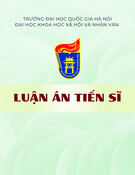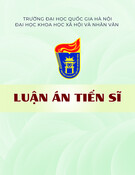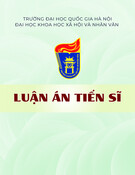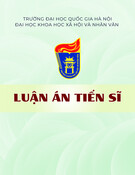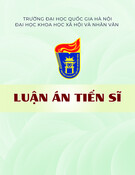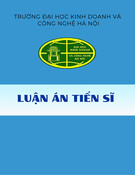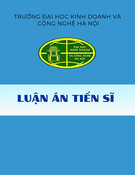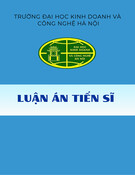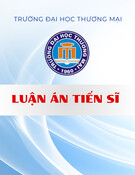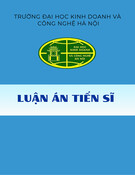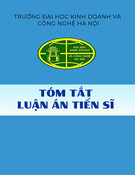MINISTRY OF EDUCATION
AND TRAINING
VIETNAM ACADEMY OF SCIENCE AND TECHNOLOGY
GRADUATE UNIVERSITY SCIENCE AND TECHNOLOGY ………***……….
VU THI MAI
STUDY ON THE PRODUCTION OF MODIFIED BIOCHAR AND
ACTIVATED CARBON DERIVED FROM CORNCOB AND THEIR
APPLICATION IN AMMONIUM REMOVAL
FROM DOMESTIC WATER
Major: Environmental Engineering Code: 62 52 03 20
SUMARY OF DOCTORAL THESIS IN
ENVORONMET TECHNOLOGY
Hanoi - 2018
1
The thesis has been completed at: Institute for Environemtal Technology – Graduate university science and technology – Vietnam Academy of Science and Technology Science supervisor: 1.Assoc.Prof.Dr Trinh Van Tuyen
2. Assoc.Prof.Dr Doan Dinh Phuong
Reviewer 1: …………………………………………………… …………………………………………………… Reviewer 2: …………………………………………………… …………………………………………………… Reviewer 3: …………………………………………………… …………………………………………………… The thesis was defended at National level Council of Thesis Assessment held at Graduate University of Science and Technology – Vietnam Academy of Science and Technology at….on…… Thesis can be futher referred at: -The Library of Graduate University of Science and Technology -National Library of Vietnam
2
INTRODUCTION
1. Background
In recent years, groundwater levels in Vietnam have been
declining in quantity and quality due to the impacts of climate change
and exploitation for economic. Vietnam has abundant surface and ground water resources (the average total runoff is 848 km3/year);
however, approximately 6 million Hanoi inhabitants receive 80% of
their drinking water from groundwater. Excessive presence of
ammonium could negatively affect the quality of groundwater and
surface water. Households might suffer potential health risks from
using directly water resources with uncontrolled quality.
In some areas in Vietnam, groundwater often contains a higher
level of iron, manganese, arsenic, ammonium concentrations than the
allowable limitation. According to previous reports, the presence of
ammonium concentration in groundwater in some areas exceeded the
surface water quality standards in Vietnam. Such typical areas are in
the northern (i.e., Vinh Phuc, Bac Ninh, Hai Duong, Hung Yen, Hanoi
provinces) and the south (i.e., Ho Chi Minh City) of Vietnam.
Numerous techniques have been applied to remove ammonium
ions from environmental bodies, such as ion exchange, membrane
technology, adsorption, nitrification-denitrification processes,
chemical precipitation, and electrochemical separation. Among these
methods, adsorption is considered an effective, inexpensive, and
simple technique for removing ammonium from water media.
Carbonaceous porous materials—activated carbon and biochar—have
been acknowledged as promising adsorbents to remove the various
3
kinds of pollutants (i.e., potentially toxic metals and dyes) from
environmental water. According to the literature, however, pristine
activated carbon (AC) often exhibits its poor maximum adsorption
capacity toward ammonium (i.e., 0.5–5.4 mg/g). Therefore, it is
necessary to apply further treatment or modification process to the
surface of AC in order to enhance its adsorption capacity to
ammonium.
According to Statistical Yearbook of Vienam 2015, the planted
area and maize production in Hanoi were approximately 21,100 ha and
102,300 tons, while the corresponding data for the whole country were
1,179,300 ha and 5,281,000 tons, respectively. Therefore, corncob
wastes can be considered an abundant, renewable, and low-cost
byproduct to prepare biochar and AC.
Therefore, the study on “Study on the production of modified
biochar and activated carbon derived from corncob and their
application in ammonium removal from domestic water” was
conducted.
2. Objectives of this dissertation
□ Develop the optimal preparation procedure of modified
biochar and activated carbon derived from an agricultural by-
product, such as corncob wastes;
□ Investigate the physical and chemical properties of
modified biochar and activated carbon;
□ Apply modified biochar and activated carbon in removal
of ammonium from synthesised and real water under batch and
column experiments;
□ Propose adsorption mechanism.
4
4. The composition of the thesis
The thesis consists of 101 pages with 38 tables, 50 images, 123
references. The thesis was composed of 3 pages, 37 pages of literature
review, 15 pages of research subjects and methods, 44 pages of
research results and discussion, conclusion of 2 pages.
THESIS CONTENT
CHAPTER 1: LITERATURE REVIEW
Ammonium contamination in ground water, methods of
ammonium treatment, overview of methods of biochar production,
modification methods in terms of biochar, activated carbon and
application of biochar as organic adsorbent, heavy metals and
ammonium treatment in water have been summarized.
The research results show that: The researches focus on the
application of biochar, modified activated carbon for ammonium
treatment in water but there have not many researches focusing on the
biochar surface modification for the adsorption of ammonium in
water. The use of corncob to produce modified biochar for the
adsorption of ammonium has not been investigated.
Based on the review of the research materials, the thesis will
focus on the following issues:
- Providing optimum conditions for the production of modified
biochar from corncob and modified activated carbon to enhance the
ammonium adsorption capacity.
- Determining the characteristics of dynamics and
thermodynamics of ammonium adsorption in the water of the
materials on the scale of batch adsorption and adsorption on the
5
column.
CHAPTER 2: MATERIALS AND METHODS
2.1. Research subjects
Adsorbent: corncob wastes were collected from Da Bac district,
Hoa Binh province, Vietnam.
Adsorbate: the ammonium solution was prepared in the
laboratory by dissolving the suitable mass of NH4Cl in doubly distilled
water to obtain a stock solution (1,000 mg/L). The synthesized water
was used in the batch experiments. Meanwhile, the real water was
collected from a well in a ammonium-polluted area (Mr. Nguyen Dinh
+, Fe3+, and Mn2+ ions in
Lam; Address: hamlet 3, Yen So commune, Hoai Duc district, Ha Noi
city, Vietnam). The concentrations of NH4
groundwater were 10.13 mg/L, 0.4 mg/L, and 0.02 mg/L, respectively.
The real groundwater was used in the column experiments.
groundwater
2.2. 1. Reagent
All chemicals used in this study were of analytical reagent grade
(purchased from Merck).
2.2.2. Device
Equipment used in materials manufacturing and analysis at the
Institute of Environmental Technology, Environmental Laboratory,
Hanoi University of Natural Resources and Environment:
- UV-VIS colorimeter (Hach, DR5000, USA) for ammonium
content analysis
- Atomic absorption spectrometer (AAS - Thermo Fisher, Solar-
6
M6) for Mn, Fe analysis.
- Analytical balance, US, accuracy 10-5 and 10-2 mg
- pH meter (Toledo, China).
- Temperature controlled shaking apparatus (GFL 1083,
Germany) for conducting static adsorption experiments.
- Nabertherm kiln (L3/11/B170, Germany) used for making
biochar, modified charcoal
2.3. Experimental
2.3.1. Adsorbent preparation
Figure 2.1 represents the preparation procedure of modified
biochar and activated carbon derived from corncob wastes. Briefly,
biochar (Bio) was prepared at different pyrolysis conditions (i.e.,
pyrolysis temperatures and times) under an oxygen-limited
environment. Subsequently, Bio was oxidized with HNO3 (BioN) to
increase the concentration of oxygen-containing functionally groups
(i.e., carboxylic group) on its surface. Lastly, BioN was treated with
NaOH (BioN-Na) to enhance its capacity cation exchange.
Meanwhile, corncob-derived activated carbon (BioP) was
prepared through a one-stage chemical activation method using
H3PO4. Similar to biochar, BioP was also treated with NaOH (BioP-
Na) to enhance its capacity cation exchange.
Notably, the pyrolysis process was done in the non-circulated
air atmosphere (i.e., within lid-enclosed crucible) at different
7
temperatures and heating times.
Figure 2.1. Schematic illustration of the preparation procedure of modified biochar and activated carbon
2.3.2. Adsorption experiment
The process of ammonium adsorption onto modified biochar
and activated carbon was conducted in batch and column experiments.
The batch experiments were run in the synthesized solutions at
different operation conditions (i.e., varying solutions pH, initial
ammonium concentrations, contact times, solution temperatures, NaCl
concentrations). Meanwhile, the column experiments were conducted
in the real groundwater to analyse the effects of different flow rates,
influent concentrations, and bed heights on the adsorption capacity.
Two fixed-bed systems comprised a downflow (using a glass
8
laboratory mini-column) and an upflow (using a column in pilot
scale). Furthermore, the adsorption reversibility was determined
through desorption experiments.
2.3.3. Adsorbent characterization
The textural characteristics of adsorbent (i.e., specific surface
area and total pore volume) were determined by the nitrogen
adsorption/desorption isotherm at 77 K (ASAP-200, Micromeritics).
Morphological property was obtained using an electron microscope S-
4800 (FE-SEM, Hitachi). The thermal stability of corncob was
measured by a thermo-gravimetric analysis (TGA; DuPont TA Q50,
USA). Qualitative information on functional groups present in the
adsorbent surface was analysed by a Fourier Transform Infrared
Spectrometer (FTIR, NEXUS 670, Nicolet, USA). The Boehm
titration method was applied to determine the quantitative information
on the acidic and basic groups on the adsorbent surfaces. The electrical
state of adsorbent surfaces in solution was characterized by the point
of zero charge (pHPZC) that was determined using the drift method.
Proximate analysis was performed by following the international
standard procedure (ASTM D2867-09, D2866, and D5832-98).
CHAPTER 3: RESULTS AND DISCUSSION
3.2. The optimal preparation condition of modified biochar
The results of ammonium adsorption (data not showed)
indicated that the optimal preparation conditions of modified biochar
were obtained. Briefly, BioN-Na was prepared at the optimal
conditions as follows: 400 °C, 60 min, 6 M HNO3 (5/1, v/w) and 0.3
9
M NaOH (20/1, v/w). Therefore, the modified carbounous adsorbent
prepared at the optimal conditions (BioN-Na) were used for further
experiments.
3.3. The optimal preparation condition of modified activated
carbon.
The results of ammonium adsorption (data not showed)
indicated that the optimal preparation conditions of modified activated
carbon (BioP-Na) were obtained. BioP-Na was prepared at 400 °C, 90
min, 50% H3PO4 (1.5/1, v/w), and 0.3 M NaOH (20/1, v/w). Therefore,
the modified carbounous adsorbent prepared at the optimal conditions
(BioP-Na) were used for further experiments.
3.4. Adsorbent characterization
3.4.1. Textural and morphology property
As expected, the BET surface area (m2/g) and total pore volume (cm3/g) of adsorbent exhibited the following order: BioP-Na (1097
and 0.804) > BioN-Na (10.4 and 0.00664), respectively. The average
pore width of BioP-Na (3.95 nm) and BioN-Na (3.71 nm) was greater
2 nm.
The results of scanning electron micrographs (Figure 3.14)
demonstrated that BioP-Na and BioN-Na had an irregular and
heterogeneous surface morphology. The formation of well-developed
pores of various sizes and shapes in BioP-Na was attributed to the
10
chemical activation method used in the activated carbon preparation.
Figure 3.14. Scanning electron microscope (SEM) image of the (a) NaOH-treated biochar and (b) NaOH-treated activated carbon
3.4.2. Surface chemistry
Figure 3.15 represents qualitative information about the
functional groups on the adsorbent surfaces. The presence of several
important function groups on the surfaces of six target adsorbents was identified at peaks at approximately 3430 cm-1 (the hydroxyl groups,
–OH, in the carboxylic groups, phenol groups, or adsorbed water), 1700 cm-1 (C=O in the carboxylic and lactonic groups), 1380 cm-1 (stretching C–O groups), and 1620 cm‒1 (the C=C double bonds in the
aromatic rings). The decrease in intensity was attributed to the change
of corresponding surface chemistry of the adsorbents, which is
consistent with the change of (1) the concentration of oxygen-
containing functional groups on the adsorbent’s surfaces, and (2) the
point of zero charge (pHPZC) (Table 3.8). The results demonstrated that
the treatment process (pyrolysis, chemical activation, oxidation, and
NaOH impregnation) significantly affected the surface chemistry of
11
the adsorbents.
Figure 3.15. Fourier transform infrared spectroscopy (FTIR) spectra of prepared adsorbents
Table 3.8. Concentration of oxygen-containing functional groups on the surface of adsorbent
pHPZC Total acid groups (mmol/g) Oxygen-containing groups (mmol/g) Carboxylic Lactonic Phenolic
7.0 0.131 0.490 0.873 1.494
5.3 4.6 0.619 1.382 1.479 2.745 0.486 0.171 2.584 4.298
4.3 0.988 1.601 0.980 3.569 Biosorbent CC Biochar Bio BioN Activated carbon BioP
3.4.3. Physical property
The results of proximate analysis demonstrated that the
modified biochar and activated carbon exhibited a low percentage of
moisture and ash content, suggesting a high quality of BioN-Na and
12
BioP-Na. In addition, a low volatile content reflects a high potential
for industrial applications or real water treatment in household scales.
Notably, a high fixed carbon content demonstrated that modified
biochar and activated carbon consist mainly of carbon.
Table 3.9. Proximate analysis of modified biochar and activated
carbon
BioN-Na BioP-Na
Yield (%)a 34.9 81.5
Moisture (%) 4.36 5.01
Volatile (%) 18.1 13.0
Total ash (%) 18.0 13.1
Fixed carbon (%) 71.9 79.3
Note: athe yield was calculated from the different mass between before and after pyrolysis for the samples of biochar and activated carbon.
3.5. Adsorption result in batch experiment
3.5.1. Effect of pH
The effects of solution pH on the NH4-N adsorption process are
provide in Figure 3.16 and 3.1. The result showed that the adsorption
process was strongly dependent on the solution pH (pHsolution). At
strong acidic condition (pH = 4), the amount of ammonium uptake
onto M-CCAC and M-CCB seems negligible. This is because (1) the + ions for excess H+ ions in the system strongly competed with the NH4 the active adsorption sites, and (2) repulsion occurred between the
NH4
13
positively charged surface of adsorbent (M-CCAC of M-CCB) and the + ions. Furthermore, the adsorption efficiency decreased when pHsolution >9.0. The decrease in adsorption capacity resulted from the +) ion into gaseous ammonia transformation of ammonium (NH4
(NH3), which makes the electrostatic attraction mechanism no longer
effective. In general, optimal pHsolution was obtained at 7.0–8.0.
Figure 3.17. Effects of initial solution pH Figure 3.16. Effects of initial solution pH on on the capacity of ammonium adsorption the capacity of ammonium adsorption onto onto (a) BioP-Na BioN-Na
3.5.3. Adsorption isotherms
The adsorption isotherms of corncob-derived adsorbents
(Figure 3.22) were classified according to their shapes as L-type
(Langmuir) isotherms, which are characterized by an initial concave
region relative to the concentration axis (concave downward curve).
Typically, the Langmuir model better fits the experimental data on the
adsorption of ammonium onto BioP-Na, BioN-Na, BioN, Bio, and CC
than dose the Freundlich model. The maximum Langmuir adsorption
capacity (qm; mg/g) at 30 °C decreased the following order: BioN-Na
(qm = 22.6 mg/g) > BioP-Na (15.4 mg/g) > BioN (8.60 mg/g) > Bio
(3.93 mg/g) > CC (2.05 mg/g), suggesting that the treatment processes + adsorption capacity onto biochar and efficiently enhanced the NH4
14
activated carbon.
Figure 3.22. Adsorption isotherms of ammonium onto corncob derived-biosorbent (CC), biochar (Bio), oxidized biochar (BioN), modified biochar (BioN-Na), pristine activated carbon (BioP), and modified activated carbon (BioP-Na)
3.5.4. Adsorption kinetics
The effects of contact time on the adsorption process were
examined at different initial ammonium concentrations (10 mg/L, 20
mg/L, and 40 mg/L) and operation temperatures (20 °C, 30 °C, and 40
°C). As expected, the adsorption process reached a fast equilibrium at
approximately 60 min (Figure 3.17 and 3.18). The experimental data
of adsorption kinetics were adequately described by the pseudo-
second-order equation. The adsorption rate (k2; g/mg × min) was
calculated from this model. The results demonstrated that the
adsorption rate of ammonium onto BioP-Na and BioN-Na at an initial + concentration of 10 mg/L increased when the temperature NH4
15
increased. The k2 values exhibited the following order: 20 °C (k2 = 0.04
g/mg × min) < 30 °C (0.09) < 40 °C (0.14) for BioP-Na, and 20 °C
(0.06) < 30 °C (0.15) < 40 °C (0.21) for BioN-Na.
Moreover, in the same operation conditions, BioN-Na exhibited
higher k2 values than BioP-Na, suggesting that the ammonium
adsorption process onto BioN-Na occurred faster than that onto BioP-
Na. Notably, the activated energy (calculated from the Arrhenius
equation) of the process of ammonium adsorption onto BioP-Na (Ea =
47.89 kJ/mol) and BioN-Na (52.46 kJ/mol) demonstrated that ion
Figure 3.18. Effects of contact time on the capacity of ammonium adsorption onto BioN-Na
Figure 3.19. Effects of contact time on the capacity of ammonium adsorption onto BioP-Na
exchange played an important role in the adsorption mechanism.
3.5.5. Adsorption thermodynamics
As showed in Figure 3.25, the adsorption process was strongly
dependent on the operation temperature. The amount of ammonium
adsorption onto modified biochar and activated carbon decreased
when the temperature increased, which implies that the ammonium
adsorption was an exothermic process. The qm values at 20 °C, 35 °C,
16
and 50 °C were as follows: 24.52 mg/g > 22.58 mg/g > 10.40 mg/g for
BioN-Na, and 17.03 mg/g > 15.40 mg/g > 11.99 mg/g for BioP-Na,
respectively.
Essentially, when the adsorption process reached a true
equilibrium, the equilibrium constant (KC; dimensionless) can be
obtained (Figure 3.25). In this case, the adsorption thermodynamic
parameters (∆G°, ∆H°, and ∆S°) can be directly calculated from the
well-known van’t Hoff equation.
change (∆G°) all investigated temperatures indicate that the NH4
Table 3.20 shows that the negative value of Gibbs energy +-N adsorption process onto modified biochar and activated carbon
in entropy (∆S°) suggest that the organization of NH4
occurred spontaneously. Meanwhile, the positive values of the change + ions at the solid/liquid interface becomes more random during the adsorption
process. Furthermore, the negative values of the change in enthalpy
(∆H°) reflect the exothermic nature of the adsorption process, which
was demonstrated by a decrease in the adsorption capacity (qe; Figure
3.25) and equilibrium constant (KC; Table 3.20) at a higher
temperature.
17
Figure 3.25. Effects of temperature on the adsorption process of (a) BioN-Na and (b) BioP-Na
Table 3.20. Thermodynamic parameters of ammonium adsorption onto modified biochar and activated carbon
KC T (K) Van’t Hoff equation ΔG° (kJ/mol) ΔH° (kJ/mol)
32.92 32.53 31.48 –8.512 –8.917 –9.263
Modified biochar (BioN-Na) 293 y = 140x + 308 3.02 323 R² = 0.9185 Modified activated carbon (BioP-Na) 293 308 323 y = 39x + 3.18 R² = 0.982 27.35 27.13 27.02 –8.060 –8.452 –8.852 –1.164 –0.320 ΔS° (kJ/mol × K) 0.0251 0.0264
3.5.6. Co-existent effects of other cations
The Fe3+, Ca2+, and Mn2+ cations are commonly present in
groundwater in Hanoi. Therefore, they were selected as the foreign +-N cations in this study. The results showed that the amount of NH4
adsorbed onto the adsorbents (BioN-Na and BioP-Na) remarkably decreased with an increase in the concentrations of Fe3+, Ca2+, and Mn2+ ions (Figure 3.26). This is presumably because: (1) a screening
positively charged adsorbent surfaces and the NH4
effect (known as the electrostatic screening) occurred between the + ions, and (2) there + ions and the Fe3+, Ca2+, and Mn2+ is a competition between the NH4
18
ions for the adsorbing or exchanging sites on the adsorbent’s surfaces (i.e., —COO– or —COONa+).
Figure 3.26. Effects of the presence of other cations on the adsorption capacity of modified biochar and activated carbon
3.5.7. Desorption study and adsorption mechanism
The adsorption efficiency of ammonium ions using various
desorbing agents is provided in Figure 3.27. The order of ammonium
desorption from BioN-Na and BioP-Na was as follows: (43% and
41%) > NaCl (34% and 29%) > NaCl + NaOH (28% and 23%) >
NaOH (22% and 17%) respectively. The percentage of ammonium
desorbed by HCl was assumed to correspond to both electrostatic
attraction and ion exchange mechanisms, and thus it can be concluded
that approximately 41% of ammonium ions was removed from the
solution (adsorbed onto BioN-Na and BioP-Na) through electrostatic
19
attraction and ion exchange mechanisms.
50
BioP-Na
BIoN-Na
40
30
20
n o i t p r o s e D
%
10
0
HCl 0,1M
HCl 1M
NaCl 0,5M NaOH 0,5M +
NaOH 0,5M
NaCl 0,5M
+-N desorbed using various
Figure 3.27. Percentage of NH4 desorbing agents
3.6. Adsorption result in column experiment
3.6.1. Adsorption performance in laboratory mini-column
(downflow)
3.6.1.1. Effect of solution flow rate
20
Figure 3.28. Breakthrough curves for different flow rates BioN-Na Figure 3.29. Breakthrough curves for different flow rates BioP-Na
When the adsorption system was controlled at a low flow rate,
the NH4+ ions would have more time to contact with modified
biochar, resulting in greater removal of NH4+ ions from the solution.
As a result, the breakthrough and exhaustion time (Table 6)
dramatically decreased from 3700 min to 1020 min and from 4980 min
to 1620 min as the flow rate increased from 1 mL/min to 3 mL/min,
respectively (BioN-Na). For BioP-Na, the breakthrough and
exhaustion time (Table 6) dramatically declined from 3000 min to 700
min and from 4500 min to 1300 min as the flow rate rose from 1
mL/min to 3 mL/min, respectively. A higher flow rate causing a higher
adsorption rate.
3.6.1.2. Effect of influent ammonium concentration
Figure 3.30. Breakthrough curves for different feed concentrations, BioN-Na
Figure 3.31. Breakthrough curves for different feed concentrations BioP-Na
The effects of initial ammonium concentration (Co; mg/L) on the
process of ammonium adsorption are described in the breakthrough curves
Figure 3.30 (BioN-Na) and Figure 3.31 (BioP-Na). Generally, The change
in concentration gradient demonstrated a strong effect on the breakthrough
and exhaustion times. The breakthrough time of the ammonium adsorption
process onto BioP-Na and BioN-Na was as follows: 1100 min and 1500
min at Co = 10 mg/L > 450 min and 650 min at 20 mg/L > 120 min and
21
500 mg/L at 40 mg/L, respectively.
The breakthrough and exhaustion times remarkably decreased with + concentrations because the adsorbing sites on the an increase in inlet NH4
modified adsorbent’s surface became quickly saturated. Generally, a higher
influent concentration resulted in the higher amount of ammonium
adsorbed because of the greater driving force to the modified adsorbent’
surface (Chowdhury, 2013).
3.6.1.3. effect of bed height
The breakthrough curves (Figures 3.32–3.33) describe the effects
of ammonium adsorption onto BioN-Na and BioP-Na at different
column heights at an influent rate of 1 mL/min and an influent
ammonium concentration of 10 mg/L.
Figure 3.33. Breakthrough curves for Figure 3.32. Breakthrough curves for different bed height, BioN-Na different bed height, BioP-Na The increasing breakthrough and exhaustion times at a higher bed
height were attributed to the enlargement of mass transfer zones
(increases the contact time between the ammonium solution and the
modified adsorbents in the column).
In addition, as the increase in the column height of modified
22
biochar and activated carbon also increased, which means increasing the
+ ion will be adsorbed
amount of adsorbing sites on, so that more NH4
on modified biochar and activated carbon.
The highest column adsorption efficiency was obtained at a
column height of 16.2 cm (BioN-Na) and 15.8 cm (BioP-Na) under
fixed other operation parameters, such as a flow rate (1 mL/min) and an
initial ammonium concentration (10 mg/L).
3.6.2. Adsorption performance in pilot scale (upflow)
On the basis of the adsorption results conduced in the
laboratory-scale column (Section 3.6.1), the pilot scale adsorption
study of BioN-Na was performed to evaluate the change of adsorption
capacity of BioN-Na toward ammonium.
The appropriate operating conditions at the column mode in the
laboratory scale were hydraulic speed of 0.6 m/h (1 ml/min), the
contact time of 15 minutes and over, therefore, on the pilot column,
hydraulic speed should be selected in the range of 0.4 to 0.8 m/h to
investigate the appropriate hydraulic speed.
In order to utilize the existing adsorption column (column
height of 60cm, column diameter of 14cm), the volume of biochar and
incoming water flow was selected to achieve the contact time of water
with biochar greater than 15 minutes.
Table 3.26. The length of mass transfer layer L of BioN-Na biochar on the pilot system Thời Thời gian gian bão thoát, tb hòa, ts (phút) (phút) Lưu lượng nước, ml/phút Chiều cao cột, H (cm) Nồng độ amoni đầu vào, Co, mg/l
23
Độ dài tầng chuyển khối, L (cm) 7.49 15.75 17.94 Hiệu suất hấp phụ cột, η (%) 75.04 47.51 40.20 10 10 10 115 154 205 30 30 30 11220 7620 6020 8420 3620 2420
Table 3.26 shows that the adsorption capacity of BioN-Na was
insignificant dependent on the flow rate (i.e., 115, 154, and 205
min/L). In contrast, the breakthrough and saturation times was
strongly dependent on the flow rate: 8420 min and 11220 min at 115
mL/min > 3620 min and 7620 min at 154 mL/min > 2420 min and
6020 min at 205 mL/min, respectively.
The adsorption capacity of BioN-Na in the pilot-scale column
ranged from 6.83 mg/g to 7.05 mg/g, which is significantly lower than
that in the laboratory-scale column (10.8 mg/g).
Table 3.27. Ammonium adsorption capacity of BioN-Na on pilot
scale.
Nồng độ amoni đầu vào, Co (mg/l) Tốc độ dòng chảy Q (ml/phut)
10 10 10 115 154 205 Chiều cao cột, h (cm) 30,0 30,0 30,0 Dung lượng hấp phụ cột, q (mg/g) 6,83 7,05 7,05
As expected, the ammonium adsorption capacity of BioN-Na
and BioP-Na in the laboratory-scale column (ranging from 8.08 to
10.8 mg/g) was generally higher than that of some other adsorbents
reported in the literature.
Chapter 4: CONCLUSIONS
The dissertation developed a simple method to prepare
modified biochar and activated carbon derived from corncob wastes.
They were characterized and apply to remove ammonium ions from
environmental water under various batch and column experiments. It
can be concluded that:
The optimal preparation conditions of target adsorbents were
obtained at (1) a pyrolysis temperature of 400°C and time of 60 min, 24
6 M HNO3 (an impregnation ratio of 5/1; volume of HNO3 per mass
of precursor; w/v), and 0.3 M NaOH (20/1; w/v) for modified biochar
(BioN-Na), and (2) 400 °C, 90 min, 50% H3PO4 (1.5/1, v/w), and 0.3
M NaOH (20/1, v/w) for modified activated carbon (BioP-Na).
Thermogravimetric analysis indicated that the endset
temperature of corncob was approximately 400°C. The results of
FTIR, pHPZC, and Boehm titration suggested that BioP-Na and BioN-
Na possessed abundant oxygen-containing functional groups. BioP-
Na and BioP-Na were considered as a carbonaceous mesoporous
material. BioP-Na and BioN-Na possessed a low moisture, volatile,
and total ash content, but high fixed carbon.
The ammonium adsorption process in the static state is
advantageous in neutral pH and lightly alkaline environment, it
reached the equilibrium after 60 minutes and was in accordance with
the pseudo-second-order equation. Maximum ammonia adsorption
capacity was 22.6 mg/g for BioN-Na and 16.6 mg/g for BioP-Na. This
capacity was 3-5 times higher than unmodified biochar at the same
pyrolysis conditions.
Ammonium adsorption capacity in water was reduced in the
presence of competitive factors (Mn, Fe, Ca). The results of the
desorption studies show that the ammonium adsorption process on
modified biochar is in accordance with the mechanism of ion
exchange and electrostatic attraction force.
The column experiments in laboratory mini-column
(downflow) demonstrated that the longest breakthrough time was
obtained at 3700 min for BioN-Na and 3000 min for BioP-Na within
25
the experimental conditions: a flow rate of 1 min/L, initial ammonium
concentration of 10 mg/L. The column adsorption capacity of BioN-
Na and BioP-Na was 10.8 mg/g and 7,8 mg/g, respectively.
Meanwhile, the model of pilot-scale adsoption at the column
mode for BioN-Na was tested. At this scale (Q = 154 – 205 ml/min,
influent ammonium concentration of 10 mgN/l), the column
adsorption capacity of modified biochar was 7.05 mg/g.
Therefore, it was experimentally proven that the modified
biochar (BioN-Na) is an effective, inexpensive, and renewable
adsorbent that can be used for highly efficient removal of ammonium
26
from real groundwater.
NEW FINDINGS OF THE THESIS
Two promising adsorbents with highly removal efficiency of
ammonium from water media were developed from abundant and
renewable corncob wastes. They are modified biochar (BioN-Na) and
modified activated carbon (BioP-Na) that were prepared through a
+-N ions.
simple modification method to increase their cationic exchange
capacity toward NH4
The adsorption studies were conducted in batch and column
experiments at different operation conditions. In batch experiments,
the maximum Langmuir adsorption capacity of BioN-Na (22.6 mg/g)
toward ammonium ions was significant higher than that of BioP-Na
(16.6 mg/g), which is approximately 2–5 times higher than pristine
biochar and activated carbon. The column experiments, which were
conducted in a glass laboratory mini-column, demonstrated the
maximum Thomas adsorption capacity of BioN-Na (10.8 mg/g) and
BioP-Na (7.8 mg/g). Meanwhile, the column experiments in a pilot
scale showed that the maximum Thomas adsorption capacity of BioN-
27
Na was obtained as 7,05mg/g.
LIST OF WORKS HAS BEEN PUBLISHED
1. Thi Mai Vu, Van Tuyen Trinh, Dinh Phuong Doan, Huu Tap Van,
Tien Vinh Nguyen, Saravanamuthu Vigneswaran, Huu Hao Ngo,
Removing ammonium from water using modified corncob-
biochar, Science of the Total Environment, 2017, (579): 612-619.
2. Vũ Thi Mai , Trinh Van Tuyen, Experimental treatment of
groundwater in Hanoi by carbonized products from corn-cob
waste, Tạp chí Khoa học và Công nghệ, Viện HL KHCN Việt
Nam, 2014, 52 (3A): 104-110.
3. Vũ Thi Mai, Trinh Van Tuyen, Modification of Charcoal from
Corn-cob for Enhancement of Ammonium Removal from Ground Water, Proceedings of the 7th VAST – AIST workshop, Research
collaboration: review and perspective, 2015, Hà Nội.
4. Vũ Thị Mai, Trịnh Văn Tuyên, Nghiên cứu khả năng xử lý amoni
trong môi trường nước của than sinh học từ lõi ngô biến tính bằng
H3PO4 và NaOH, Tạp chí Khoa học Đại học Quốc Gia Hà Nội,
Các khoa học Trái đất và Môi trường, 2016, (32-1S): 274-281.
28

